The moment I clasped my first classical guitar capo onto the neck of my beloved instrument, my world of music changed irrevocably. It was a humble piece of gear – a wooden ‘cejilla’ that would go on to unlock a whole new universe of possibilities on my fingerboard. Yet the charm of its simplicity belied the transformation it was about to introduce in my playing style.
My name is Richard Miller. With over five decades of strumming guitars steeped in the rich traditions of classical and flamenco styles, I’ve seen firsthand the profound impact that the seemingly insignificant capo can have on guitar music. Its ability, for example, to manipulate the pitch, timbre, and chord voicings without requiring a retuning of the guitar is nothing short of sorcery.
So why is it that despite its magical capabilities, this tool remains a somewhat underused accessory in the guitarist’s toolkit? My theory is lack of knowledge, which is why I’ve compiled this comprehensive guide for you. Here, using my experience supplemented with objective data, we’ll delve into a clear understanding of classical guitar capos, draw comparisons, and explore guidelines to utilize them effectively. From the flamenco guitar’s ‘cejilla’, to understanding the nuances of capos for a 6-string or a wide neck guitar, this write-up aims to be your one-stop guide. So, tune in and get ready to elevate your classical guitar performance to new stratospheres.
Understanding Guitar Capos
Acoustic vs Classical Capo
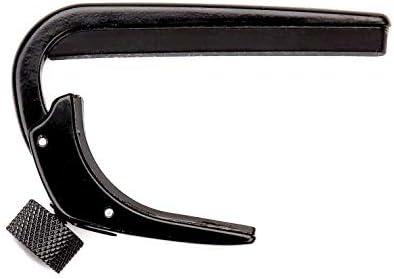
Continuing along our guitar capo discussion, let me delve into the specific differences between acoustic guitar capo and classical capo. From my experiences, there’s a real distinction in how both can impact the tonalities of your guitar.
Acoustic guitar capos are designed for steel-string guitars. They utilize a strong spring or screw mechanism to hold the strings, resulting in a bright, clear sound.
On the contrary, your classical capo, which is designed for nylon-string guitars, exerts softer, more evenly distributed pressure on the strings. This more gentle grip facilitates the resonance classical guitars are renowned for, whilst avoiding unnecessary stress on the strings.
So, the key difference in this guitar capo comparison boils down mainly to the structure and pressure mechanisms. The acoustic variety often harnesses a more rigorous, concentrated grip, whereas a classical capo has a more delicate, encompassing approach.
Rotate between the two based on the distinct sound you desire. I’ve played both styles and I can tell you, whether you want to strum forth a catchy chorus on your acoustic or subtly emphasize the harmonies on your classical, selecting the appropriate capo can make all the difference.
Fine-tuning your capo use is just one aspect of mastering your instrument. There’s much more to discuss including nylon, 6-string, and 8-string capos, and how each can be utilized in various styles like classical and flamenco. Similarly, other considerations pop up when dealing with wide neck guitars. So, stay tuned.
Nylon, 6-string, 8-string, and 10-string Capos
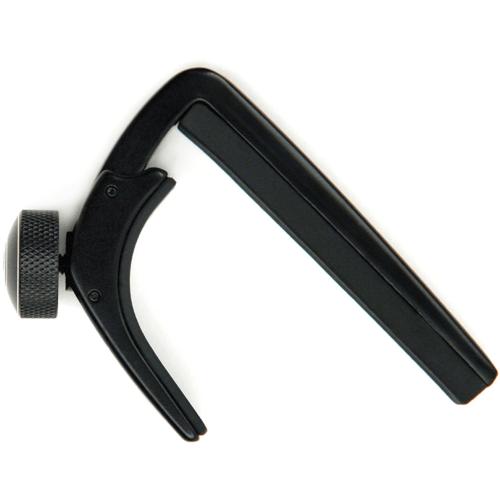
Commencing my musical journey with a 6-string guitar, the choice of the appropriate capo was vital for success. Over time, my experimentation with 8-string and 10-string guitars amplified this importance. Let’s deep-dive into the specifics of nylon, 6-string, 8-string, and 10-string capos, and the significance of pinpointing the right one.
Firstly, the capo for a nylon string guitar is designed to easily accommodate the wide neck and flat fingerboard typical to classical guitars. As these guitars have softer strings, their capos require a strong but gentle grip to eliminate any possibility of damaging the nylon strings.
Moving to capos for 6-string guitars, they are the most common. They’re created to comfortably fit the curve of the 6-string electric or acoustic guitar’s neck. However, the inherent charm lies in its versatility as it can be adapted to fit other guitar types as well.
A capo for 8-string guitar may seem hard to come by due to its unique feature of two extra strings. However, upon expansion of my musical horizon to include 8-string guitars, a wider, strong clamping capo tailored to accommodate the extra width proved to be indispensable for its sharp, clear tones.
Finally, an 10-string guitar capo was a game changer in my musical journey. It was designed to cover the incredibly large range of the 10-string guitar’s fretboard. Deciphering its use was a doorway to a new world of exciting, complex melodies that were previously unreachable.
As a sum of my constant exploration and practice with various capos, I’ve learned that a significant ingredient in achieving the right sound is selecting the correct capo for your guitar. It’s not just an accessory, but an essential tool to unlock the full potential of your instrument. Remember, the ideal capo, whether for 6, 8, or 10-string guitars, does more than just change keys—it deepens your guitar’s tonality, broadening your musical canvas.
Transitioning towards more genre-specific capo usage, let’s delve into capo tips for classical and flamenco styles, two cornerstones of traditional guitar music.
Capo Tips for Classical and Flamenco Styles
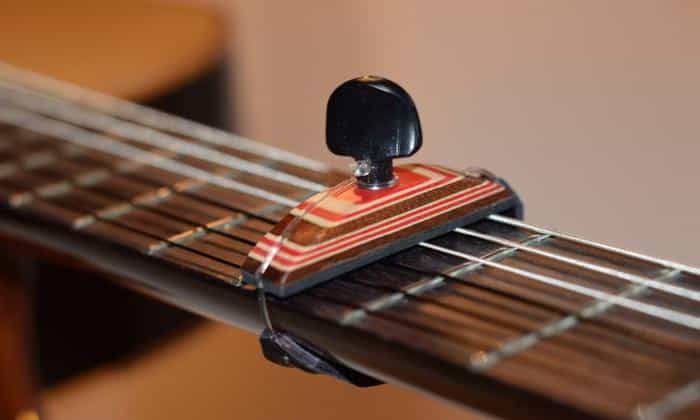
In the realm of classical and flamenco guitar, I’ve been graced with the opportunity to explore and express my artistry in numerous ways. My tireless hours of practice, myriad performances, countless jam sessions, coupled with the experimentation of various techniques, have ushered in a wealth of knowledge and perspective. Among my most valued companions on this journey has been the humble guitar capo, an essential tool for effective transposition and precise intonation.
Your key to mastering the use of capos for classical and flamenco styles? It’s understanding the mechanics behind how to use a capo. It unlocks possibilities beyond the scope of your imagination while erasing the limitations imposed by an untransposed guitar. Remember, a well-placed capo affords you the luxury not only of changing keys but also embellishing your playstyle.
In the realm of flamenco, for instance, there’s a specific piece that employs a capo on the 2nd fret to create a fret-board illusion. This seamlessly transposes the key to the relative major and results in a lush, vibrant tonality that enriches the composition’s overall character. The pivotal concept here? It’s key transposition with a capo – this revelation can transform both your theoretical understanding and practical application.
Now, want to master the use of capos for classical and flamenco guitar styles? Here’s the secret—it resides not only in knowing where to position it, but also in mastering capo tension adjustment. Too much pressure can result in sharp intonation and makes the strings harder to depress, creating discomfort and potential string buzz. Conversely, too little tension may fail to hold down the strings effectively, leading to a muted or buzzing sound. It’s vital to strike that perfect middle ground.
Classical guitar intonation with a capo deserves specific mention here. A well-adjusted capo can bring enhancement and ideal intonation in classical guitar. The exact placement of the capo can subtly alter the landscape of sound, and experiencing this, understanding the nuanced differences, underscores the true beauty of our craft.
The universal truth I’ve discovered is that the journey with your capo will be full of experimentation and discovery. It will, like any skill in music, take patience and practice. But the revelation of depth and added musicality it brings to your playing is a reward that’s well worth the time and effort.
So, take my shared experiences, try out my tips, engage with your capo, and explore the limitless possibilities it can bring to your musical journey. This beloved tool, as accompaniment to your passion and dedication, will undoubtedly transform your classical and flamenco guitar skills.
Choosing the Right Capo for Wide Neck Guitars
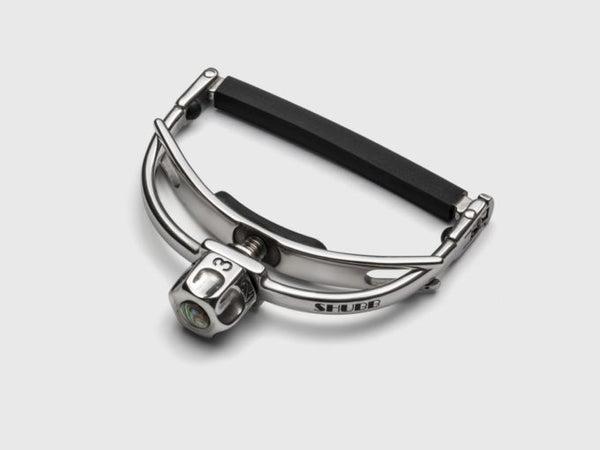
Ever found yourself deeply immersed in a solo only to be pulled back by a painfully out-of-place buzz? Perhaps you’ve rehearsed your flamenco techniques for your 10-string guitar to perfection, but that same old string buzz with capo seems determined to sabotage your performance? I’ve been there. I’m willing to bet it wasn’t your guitar playing to blame. You might be using the wrong capo.
Throughout my career, a good number of broad-necked guitars have found their way into my hands, each demanding a suitable and specifically designed capo for wide neck guitar. Understanding the relationship between the capo design and the guitar neck width is fundamental in delivering clear, buzz-free tunes. My journey with wide-neck guitars taught me the importance of having the right capo, and I’m here to share my insights to help you avoid that undesired string buzz.
Navigating the world of guitar capos, especially for wide neck guitars, can be a daunting task. The marketplace is flooded with endless choices, each claiming to be the best option. The trick lies in knowing your neck width and using a capo designed precisely for that. A capo that is too narrow will not cover all the strings, leading to the notorious ‘string buzz’. Likewise, a capo too wide can put unnecessary pressure on the outer strings, affecting your intonation.
There’s a capo out there for every size and shape of guitar neck. When you finally find the right capo for your wide neck guitar, you will notice an immediate improvement in the playability of your instrument. Also, it will impact your performance in ways that you never thought possible. For wide neck guitars specifically, a capo with an adjustable radius will work like magic.
Being discerning will make all the difference. Doing a bit of research goes a long way when it comes to choosing the right capo for your guitar. I can testify that the sweet, clear sound of a well-practiced piece, unmarred by buzzing or binding, is worth every bit of the effort invested in finding the right capo. Remember, an ideal capo is one that sounds good, feels good in use and doesn’t throw your guitar out of tune.
While we still have much to explore about capos, I hope this segment has equipped you better in your search for the perfect capo. A harmonious guitar performance need not be a far-off dream with the right capo, even for those lovely wide neck guitars.
Top Capo Brands for Classical Guitars
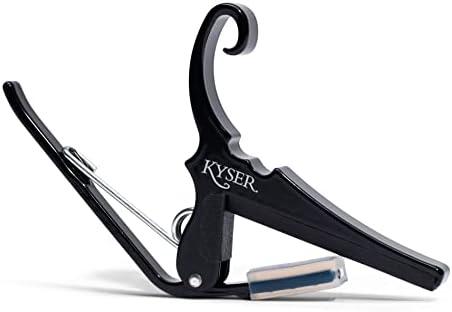
As a seasoned classical guitar player, over the years I’m proud to have amassed valuable hands-on experience with a variety of capos. It’s a pleasure to pass on the wisdom I’ve gleaned, streamlining your route to finding the perfect capo for your classical guitar.
Are all guitar capo brands created equal? Let’s dive into the world of guitar capos together. Drawing from the multitude of capo encounters in my journey, I’ve discerned three brands that consistently deliver superior quality and performance for classical guitars: the D’Addario classical capo, Shubb capo for classical guitar, and the G7th capo for classical guitar.
The D’Addario classical capo is a value-packed choice, perfectly balancing cost and performance. It boasts a sleek, lightweight design that marries beautifully with the sophistication of classical guitars. The micro-adjustment mechanism provides precise tension control, ensuring optimal tone without compromising the guitar’s intonation.
Next, the Shubb capo for classical guitar. On my classical guitar, the Shubb capo has delivered nothing short of aplomb. Its unique design creates a perfectly balanced pressure on each string. It adjusted intuitively to the wider fingerboard and flat frets on my classical guitar, a feature that avid classical guitar enthusiasts will certainly appreciate. Moreover, its resilient rubber neither degrades over time nor imparts any unwanted vibe to your guitar’s tone.
Moving to the G7th capo for classical guitar, which warrants a special mention due to its game-changing Adaptive Radius Technology (ART). This ensures each string is pressured with equal force, maintaining your classical guitar’s pure tonality. Additionally, its featherweight design makes it feel virtually non-existent, enabling uninterrupted playability for intricate fingerstyle.
While these brands have consistently resonated with my classical guitar experiences, the best capo for you ultimately aligns with your personal style and instrument specifics. In the upcoming sections, we’ll delve deeper into how to make that choice, providing practical guidance and answering potential queries. All with the aim to shed light on your journey to perfect harmony between your classical guitar and its capo companion.
FAQs
What is a classical guitar capo?
Why might I need a capo for my classical guitar?
How do I choose the right capo for a classical guitar?
Conclusion
By this stage, you’ll have a comprehensive understanding of the varying facets of the classical guitar capo. We analyzed the distinct characteristics of capos for different guitars — from the nuanced flair of a flamenco guitar capo to the hearty resonance a capo can deliver on an 8-string. We’ve unveiled insightful capo tips for enriching flamenco and classical styles and guided you on the search for the best guitar capo tailored to your sound.
Moving on, here’s something to ponder. Ready to take your classical guitar playing to the next level with the right capo? In my experience, the right capo ultimately boils down to personal style, guitar type, and your musical aspirations.
With insights from my roller-coaster ride of guitar experiences, I trust you’re now in a stronger position to make a well-informed capo choice that matches your guitar’s personality and amplifies its unique voice. So take your time, test different capos, and let the music lead you. Here’s to a musical journey that will not only fine-tune your sound but also embrace the boundless possibilities a carefully chosen capo can unfurl.